The human sense of touch is known as the somatic or somatosensory system. Touch is the first sense developed by the body, and the skin is the largest and most complex organ in the somatosensory system. By gathering external stimuli and interpreting them into useful information for the nervous system, skin allows the body to function successfully in the physical world. Touch receptors in the skin have three main subdivisions: mechanoreception (sense of pressure), thermoreception (sense of heat) and nociception (sense of pain). Receptor cells in the muscles and joints called proprioceptors also aid in the somatosensory system, but they are sometimes separated into another sensory category called kinesthesia.

Human skin receptors
Mechanoreceptors can be free receptors or encapsulated. Examples of free receptors are the hair receptors at the roots of hairs, while encapsulated receptors are the Pacinian corpuscles and the receptors in the glabrous (hairless) skin: Meissner's corpuscles, Ruffini's corpuscles, and Merkel's discs.
Somatosensory Systems
The somatosensory system uses specialized receptor cells in the skin and body to detect changes in the environment. The receptors collect and convert physical stimuli into electrical and chemical signals through the transduction process and send these impulses to the nervous system for processing. Sensory cell function in the somatosensory system is determined by location.
The receptors in the skin, also called cutaneous receptors, tell the body about the three main subdivisions mentioned above: pressure and surface texture (mechanoreceptors), temperature (thermoreceptors), and pain (nociceptors). The receptors in the muscles and joints provide information about muscle length, muscle tension, and joint angles.
Mechanoreception
Mechanoreceptors in the skin give us a sense of pressure and texture. These receptors differ in their field size (small or large) and their speeds of adaptation (fast or slow). Thus, there are four types of mechanoreceptors based on the four possible combinations of fast vs. slow speed and large vs. small receptive fields. The speed of adaptation refers to how quickly the receptor will react to a stimulus and how long that reaction will be sustained after the stimulus is removed. Rapidly adapting cells allow us to adjust grip and force appropriately. Slowly adapting cells allow us to perceive form and texture. The receptive field size refers to the amount of skin area that responds to the stimulus, with smaller areas specializing in locating stimuli accurately.
Thermoreception
Thermoreceptors detect changes in temperature through their free nerve endings. There are two types of thermoreceptors that signal temperature changes in our own skin: warm and cold receptors. Our sense of temperature is a result of the comparison of the signals from each of the two types of thermoreceptors. These receptors are not good indicators of absolute temperature, but they are very sensitive to changes in skin temperature.
Nociception
Nociceptors use free nerve endings to detect pain. Functionally, nociceptors are specialized, high-threshold mechanoceptors or polymodal receptors. They respond not only to intense mechanical stimuli but also to heat and noxious chemicals—anything that may cause the body harm. Their response magnitude, or the amount of pain you feel, is directly related to the degree of tissue damage inflicted.
Pain signals can be separated into three types that correspond to the different types of nerve fibers used for transmitting these signals. The first type is a rapidly transmitted signal with a high spatial resolution, called first pain or cutaneous pricking pain. This type of signal is easy to locate and generally easy to tolerate. The second type is much slower and highly affective, called second pain or burning pain. This signal is more difficult to locate and not as easy to tolerate. The third type arises from viscera, musculature, and joints; it is called deep pain. This type of signal is very difficult to locate, and often it is intolerable and chronic.
Proprioception
Proprioceptors are the receptor cells found in the body's muscles and joints. They detect joint position and movement, and the direction and velocity of the movement. There are many receptors in the muscles, muscle fascia, joints, and ligaments, all of which are stimulated by stretching in the area in which they lie. Muscle receptors are most active in large joints such as the hip and knee joints, while joint and skin receptors are more meaningful to finger and toe joints. All of these receptors contribute to overall kinesthesia, or the perception of bodily movements.
Somatic System Disorders
A somatic system disorder (formerly called a somatoform disorder) is a type of psychological disorder related to the somatosensory system. Somatic system disorders present symptoms of physical pain or illness that cannot be explained by a medical condition, injury, or substance. The patient must also be excessively worried about his symptoms, and this worry must be judged to be out of proportion to the severity of the physical complaints themselves. This class of disorders includes:
- Conversion disorder: A somatic symptom disorder involving an actual loss of bodily function such as blindness, paralysis, or numbness due to excessive anxiety.
- Illness anxiety disorder: A somatic symptom disorder involving persistent and excessive worry about developing a serious illness. This disorder has recently been reviewed and expanded into three different classifications.
- Body dysmorphic disorder: The afflicted individual is concerned with body image and is excessively concerned about and preoccupied with a perceived defect in his or her physical appearance.
- Pain disorder: Chronic pain experienced by a patient in one or more areas that is thought to be caused by psychological stress. The pain is often so severe that it prevents proper body function. Duration may be as short as a few days or as long as many years.
- Undifferentiated somatic symptom disorder – only one unexplained symptom is required for at least 6 months.